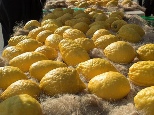 Customers spend hours looking for the most perfect lulavim, esrogim, hadasim and aravos. And despite much alarm and fear, the great lulav shortage of 2011 has not transpired, and that’s the official word from the mochrim on the street.
Customers spend hours looking for the most perfect lulavim, esrogim, hadasim and aravos. And despite much alarm and fear, the great lulav shortage of 2011 has not transpired, and that’s the official word from the mochrim on the street.
Despite a ban imposed this year by Egyptian authorities on the export of lulavim, the streets of Geulah and Meah She’arim in Yerushalayim are awash with daled minim and trade is brisk.
“There’s no shortage really,” says Arba Minim mocher Yehudah Cohen. “Maybe prices are a bit more expensive this year, by 10 or 20 shekels, but they’re not much more than the average year.”
And in fact, there are even some Egyptian varieties available, with a couple of merchants displaying El-Arish lulavim from the Sinai.
Menachem, an experienced Arba Minim dealer selling his lulavim for between NIS 100 and 120, concurred with his competitor Yehudah, but added that what is in short supply is hadasim. Specifically, the availability of the highest quality hadasim is low this year and they are selling for as much as 120 shekels, far more than usual.
Menachem sold one particularly beautiful esrog this year for NIS 1,000, a steep price.
The wholesale price of an esrog, he said, can range from NIS 15 – NIS 30, so the markup on the most mehudar esrogim is substantial to say the least.
“It may seem expensive but there are a lot of high outlays for an Arba Minim trader,” Menachem says. “I may buy a crate of say 100 esrogim from the orchard, 80 percent of which may not even be kosher which I can’t sell, so you have to take those costs into account.”
One customer, having found a particularly fine esrog, took it off to a local posek for confirmation that it is mehudar, promising to pay once he got approval.
“People are honest,” says Menachem. “He’s not going to steal it. Anyway, you can’t even perform the mitzvah if the Arba Minim aren’t your own, so it’s no problem.”
Other mochrim work on a partnership arrangement with the principle suppliers, such as Yisroel in the heart of Geulah, who sells esrogim from the Gross orchards, collecting 20% of the proceeds with the other 80% going to Gross.
Yisroel will take delivery of approximately 1,000 esrogim this year, but says he will sell only about 600 of them. Of those, he will sell between 100 and 150 for NIS 550 and the rest for, on average, NIS 360. The 400 that remain unsold, which Yisroel said he needs to provide customers with a good selection, will be turned into esrog jam.
The selection process of an Arba Minim set is a time-consuming and intense process. Men brandish magnifying glasses, tooth picks and cotton buds with which to inspect an esrog for bletlach, or blemishes, and clean them of any superficial surface detritus.
Yaakov, a Toldos Aharon chossid, said he had spent three hours simply selecting a lulav.
“If you really value the importance of a mitzvah, then you invest your time in it,” he said.
“In truth, it’s hard to find an invalid esrog,” said another Yid. “But to fulfill the mitzvah in the most ideal way, one must find the most beautiful esrog you can. It’s not an obligation, but a will and desire to do the mitzvah as perfectly as possible.”
{Yair Alpert-Matzav.com Israel}











